Flatfeet
This is a postural deformity in which the whole sole of the foot comes in contact with the ground on standing. All children till 2 years of age will have flat feet. This is because of baby fat, which masks the development of arch and also because the arch has not developed till then. Arch develops between 2-3 years of age, but there are some individuals in which it may never develop. The arch appearswhen the foot is off the ground and disappears on weight bearing, the foot is called a supple flat foot. If the arch does not appear when the foot is off the ground then it is called a rigid flat foot.


The arch provides an elastic, springy connection between the forefoot and the hind foot. This association safeguards that a majority of the forces incurred during weight bearing of the foot can be dissipated before the force reaches the long bones of the leg and thigh. However there are no reports that conclusively prove that children with flat feet have an increased incidence of foot pain or knee pain.
Shoe inserts may not help in the development of arches. There are many studies performed to prove this.Studies have shown thatwearing shoes throughout early childhood can be detrimental to the development of a normal or a high medial longitudinal arch. Hence children should be encouraged to play barefooted on various surfaces of terrain. Slippers and sandals are less harmful compared to closed-toe shoes. Hence no special treatment is usually required for such feet. You need to consult a doctor if there is pain in foot, outward tilting of the heel, difficulty with shoes or awkwardness in walking.
Physiological flat feet should be distinguished from congenital vertical talus in which children have a convex lower border of foot. Plaster treatment and early surgical intervention is required in these children.
Another common cause for adolescent flat foot is development of talonavicular or talo calcaneal bar. Two bones are joined by abnormal bar which limits movement of the bones. The treatment of this condition includes surgical excision of bar.



